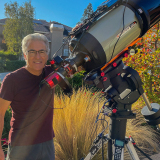INDI Library v2.0.7 is Released (01 Apr 2024)
Bi-monthly release with minor bug fixes and improvements
Optimal Sub-Exposure Calculator help
Replied by Vladimir on topic Optimal Sub-Exposure Calculator help
Please Log in or Create an account to join the conversation.
- Frederick Ruegsegger
-

- Offline
- Elite Member
-

- Posts: 211
- Thank you received: 30
Replied by Frederick Ruegsegger on topic Optimal Sub-Exposure Calculator help
ZWO ASI 6200MM Pro
ZWO ASI 6200MC Pro
ZWO ASI 178MC
ZWO ASI 290MM Mini
ZWO ASI 174MM Mini
Please Log in or Create an account to join the conversation.
- Joseph McGee
-

- Offline
- Senior Member
-

- Posts: 42
- Thank you received: 11
Replied by Joseph McGee on topic Optimal Sub-Exposure Calculator help
(I'm sorry for the delay in my reply; I was working on some performance improvements to the analyzer tool, and also trying to understand an anomaly I see when I process data from color sensors.)
But I've just created a folder on Google Drive that should be writable for anyone with this link.
drive.google.com/drive/folders/1nHlqDTHz...ofudq?usp=drive_link
I assume that Google drive will allow you to create sub-folders in this shared folder, so it would probably be best to create a "home" folder for yourself. And then upload zip files of your bias and flat images to that home folder.
If you plan to create new flats and bias images for this effort:
Remember that I will need two of each file type, (2 flats and 2 bias), for each gain value being plotted.
I use file naming format like this /%t/%T/%F/%t_%T_%F_Gain_%G_Offset_%O to help me distinguish the files. (But I can jut read the fits header if need be).
For flats I've been setting the calibration option for the ADU to 29000. But this is probably not critical, as long as the value you use is reasonable and consistent.
As I mentioned, I'm using a dimmable LED panel for my flats. But to reduce the brightness I ended up inserting about 30 sheets of printer paper between camera and the panel so that the exposure time for flats is around 1 second. But when I image at with higher gain values I've had to add a few more sheets of paper because the exposure time can fall rapidly at high gains.
I also found that my cameras leak light in quite badly. I've been creating my images in daytime, and find that I need to cover the camera with a dark cloth to avoid unwanted light in the exposure.
Thanks again for your help!
Please Log in or Create an account to join the conversation.
- Richard Francis
-

- Offline
- Premium Member
-

- Posts: 146
- Thank you received: 16
Replied by Richard Francis on topic Optimal Sub-Exposure Calculator help
I've added the curves I obtained to the Moravian folder in case they are useful. Please take note of the page from the user manual I added as well, which points out that the "gain" is a command to the driver and is not a multiplicative gain, neither in linear or dB. The conversion from the 2 values I used to multiplicative gain is given there. I suspect this might be true for all Moravian CMOS cameras, by the way.
For the QSI I also made a photon transfer curve, so I must have the data (without scope) somewhere. As I can't find them I have instead used the oldest (and best quality) through-the-scope flats I could find. If this is no good I can fish out the camera and make some more. Same story for the SBIG ST2000XM, except I never made a photon transfer curve.
I will rework the Kepler and QSI photon transfer data into the same form as the Moravian plots (easier to interpret) if you find them useful.
Cheers,
Richard
Please Log in or Create an account to join the conversation.
- Frederick Ruegsegger
-

- Offline
- Elite Member
-

- Posts: 211
- Thank you received: 30
Replied by Frederick Ruegsegger on topic Optimal Sub-Exposure Calculator help
Please Log in or Create an account to join the conversation.
- Joseph McGee
-

- Offline
- Senior Member
-

- Posts: 42
- Thank you received: 11
Replied by Joseph McGee on topic Optimal Sub-Exposure Calculator help
I was able to get the SBIG ST2000XM Data to process through my tool.
To be clear:
1) My tool only analyzes a 100x100 pixel region at the center of the sensor. (That's actually a recommend approach when performing this type of analysis).
2) The value shown for "Gain Scaled" has to do with adjusting the reported gain for the bit depth of the sensor vs the bit depth read from the fits file. So, for example, if the sensor were only 14 bits, then the Gain Scaled (e-/ADU) value would be 4 times the value reported as "Gain (e-/ADU)". (I'm working on a function that hope will detect the sensor bit depth by analyzing the intervals between pixel values, but that function is not yet active, so this output assumes the sensor is actually 16 bits).
Read Noise (ADU): 10.6161
Gain (e-/ADU): 0.6288
Gain Scaled (e-/ADU): 0.6288
Read Noise (e-): 6.6756
Full Well (e-): 41210.2823
Dynamic Range (Stop): 12.6351
After running this I looked up some specs on this camera, and the values my tool reports seem to be reasonable.
I will continue with testing on the other cameras.
Please Log in or Create an account to join the conversation.
Replied by Vladimir on topic Optimal Sub-Exposure Calculator help
Please Log in or Create an account to join the conversation.
- Joseph McGee
-

- Offline
- Senior Member
-

- Posts: 42
- Thank you received: 11
Replied by Joseph McGee on topic Optimal Sub-Exposure Calculator help
I've finished processing the data for your four cameras. I uploaded text files with results into each of your camera folders on the google share. Take a look if you are curious.
This had been a very productive exercise for me. I've made notes of a number of changes I plan to make to my calculation function.
For the most part my tool seems to be producing reasonable values. The only result I question is for the FLI Kepler, mainly because there was pattern noise in some input files, and the read noise that my tool computed was a bit higher than the value I found reported on the manufacturers site. (I actually ran a 2nd test for this camera where I selected different region to analyze, but the result was not substantially better.
I plan to make some custom camera data files for you, in case you want to use the exposure calculator. But the Moravian camera might pose a problem for the exposure calculator. My design in the exposure calculator assumed that CCD cameras do not have an ability to select gain. But this camera seems to have discrete gain values that can be chosen. So, in a way it behaves rather like a DLSR that has discrete ISO settings. So I may need to make a change to the exposure calculator to handle this type of CCD camera.
Thanks again for providing the files.
Please Log in or Create an account to join the conversation.
- Richard Francis
-

- Offline
- Premium Member
-

- Posts: 146
- Thank you received: 16
Replied by Richard Francis on topic Optimal Sub-Exposure Calculator help
I agree the Kepler has a weird fixed pattern component. It can be calibrated out, but doesn't look good in the pre-calibration frames.
Did you find the photon transfer curves of any use? If so, I can present the data I already collected for the Kepler and QSI in the same form. These may be doing something similar to you, but over a wide range of flat exposures, and dark exposures too as a variant.
Cheers,
Richard
Please Log in or Create an account to join the conversation.
Replied by vera on topic Optimal Sub-Exposure Calculator help
where i can select exposure time format
Please Log in or Create an account to join the conversation.
- Joseph McGee
-

- Offline
- Senior Member
-

- Posts: 42
- Thank you received: 11
Replied by Joseph McGee on topic Optimal Sub-Exposure Calculator help
The calculator should only display, exposures in seconds. But the calculation can produce extreme exposure times, both very short and very long, depending upon the inputs.
Can you share a screen shot of the calculator?
Please Log in or Create an account to join the conversation.
- Joseph McGee
-

- Offline
- Senior Member
-

- Posts: 42
- Thank you received: 11
Replied by Joseph McGee on topic Optimal Sub-Exposure Calculator help
For the Moravian, I made a small adjustment to the output from my tool to include the dynamic range value in both raw (no units), and in dB. So that it can be better compared to the information in the charts you provided.
My computed values are generally the same, as what I find in the charts. But there is a difference between my computation of Full Well, and that shown in the charts.The calculation for full well is gain (e-/adu) x max adu. But I use 65536 (on a 16-bit readout) as the max adu, but the charts seem to using 64000. Do you think that the reduction is to account for thermal noise, or maybe something else? (My tool does not yet consider thermal noise).
Please Log in or Create an account to join the conversation.

